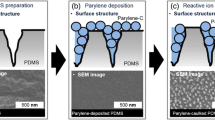Abstract
We describe here a simple and novel method to fabricate polyimide (PI) electrodes without a complex process to release completed PI electrodes from the substrates after full-curing process. We separated the PI electrodes from the Si-wafer prior to full-curing process, and these non full-cured electrodes were placed between the Kapton films, and we performed full-curing process with these sandwiched electrodes. Then, PI electrodes were easily and clearly released from the substrate without the sacrificial layers. We assessed the mechanical properties of fabricated electrodes comparing with non full-cured PI electrodes to investigate the full-curing effect between Kapton films. The electrical property was evaluated by measuring the impedance. Testing of the cyto-toxicity of full-cured electrodes using human mesenchymal stem cells (hMSCs) and mouse fibroblasts (L929) was carried out and the electrodes fabricated by proposed method were nontoxic and could be used as implantable electrodes. We also found that the electrodes, uniformly spread on the surface of mouse skulls while maintaining close contact, could successfully measure multichannel EEG signals.








Similar content being viewed by others
References
Baek D-H, Lee E-J, Moon J-H, Choi J-H, Pak JJ-H, Lee S-H (2009) Polyimide-based multi-channel arrayed electrode for measuring EEG signal on the skull of mouse. In: 31st annual international conference of the IEEE EMBS Minneapolis, Minnesota, USA, September 2–6, 2009_Oral:7022–7025
Bagolini A, Pakula L, Scholtes T, Pham H, French P, Sarro P (2002) Polyimide sacrificial layer for post-processing surface micromachining. J Micromech Microeng 12:385–389
Cheung K, Renaud P, Tanila H, Djupsund K (2007) Flexible polyimide microelectrode array for in vivo recordings and current source density analysis. Biosens Bioelectron 22(8):1783–1790
Choi J, Lee M, Kim J, Shin H (2007) A flexible multichannel electrode for mouse brain and its application to mouse EEG. In: Proceedings of NFSI & ICFBI 2007, Hangzhou, China, 12–14 October 2007, pp 230–231
Ghosh M, Mittal K (1996) Polyimides: fundamentals and applications. Marcel Dekker, New York, p 367
Ghosh I, Konar J, Bhowmick A (1997) Surface properties of chemically modified polyimide films. J Adhes Sci Technol 11(6):877–893
Jung Y, Shimamoto D, Muramatsu H, Kim Y, Hayashi T, Terrones M, Endo M (2008) Robust, conducting, and transparent polymer composites using surface-modified and individualized double-walled carbon nanotubes. Adv Mat 20(23):4509–4512
Kinney G, Kocsis B, Vertes R (1995) Injections of muscimol into the median raphe nucleus produce hippocampal theta rhythm in the urethane anesthetized rat. Psychopharmacology 120(3):244–248
Lee B, Kim H, Yu W (2009) Fabrication of long and discontinuous natural fiber reinforced polypropylene biocomposites and their mechanical properties. Fibers Polym 10(1):83–90
Linder V, Gates B, Ryan D, Parviz B, Whitesides G (2005) Water-soluble sacrificial layers for surface micromachining. Small 1(7):730–736
MacCarthy N, Wood T, Ameri H, O’Connell D, Alderman J (2006) A laser release method for producing prototype flexible retinal implant devices. Sens Actuators A Phys 132(1):296–301
Metz S, Bertsch A, Renaud P, Technol A, Dyconex A, Bassersdorf S (2005) Partial release and detachment of microfabricated metal and polymer structures by anodic metal dissolution. J Microelectromech Syst 14(2):383–391
Meyer J (2002) Retina implant—a bioMEMS challenge. Sens Actuators A Phys 97:1–9
Moon J-H, Baek D-H, Choi Y-Y, Lee K-H, Kim H-C, Lee S-H (2010) Wearable polyimide-PDMS electrodes for intrabody communication. J Micromech Microeng 20:25–32
Patil P, Turner D (2008) The development of brain-machine interface neuroprosthetic devices. Neurotherapeutics 5(1):137–146
Ragheb T, Geddes L (1990) Electrical properties of metallic electrodes. Med Biol Eng Comput 28(2):182–186
Richardson R Jr, Miller J, Reichert W (1993) Polyimides as biomaterials: preliminary biocompatibility testing. Biomaterials 14(8):627
Rousche P, Pellinen D, Pivin D, Williams J, Vetter R, Kirke D (2001) Flexible polyimide-based intracortical electrode arrays with bioactive capability. IEEE Trans Biomed Eng 48(3):361–371
Schaper C, Miahnahri A (2004) Polyvinyl alcohol templates for low cost, high resolution, complex printing. J Vac Sci Technol B Microelectron Nanometer Struct 22:3323
Stensaas S, Stensaas L (1978) Histopathological evaluation of materials implanted in the cerebral cortex. Acta Neuropathol 41(2):145–155
Stieglitz T, Beutel H, Meyer J (1997) A flexible, light-weight multichannel sieve electrode with integrated cables for interfacing regenerating peripheral nerves. Sens Actuators A Phys 60(1–3):240–243
Stieglitz T, Beutel H, Schuettler M, Meyer J (2000) Micromachined, polyimide-based devices for flexible neural interfaces. Biomed Microdevices 2(4):283–294
Westberg D, Paul O, Andersson G, Baltes H (1996) Surface micromachining by sacrificial aluminium etching. J Micromech Microeng 6:376–384
Yoon T, Hwang E, Shin D, Park S, Oh S, Jung S, Shin H, Kim S (2000) A micromachined silicon depth probe for multichannel neural recording. IEEE Trans Biomed Eng 47:1082–1087
Acknowledgments
This work was supported by grand No. 10031779 from the Strategic Technology Development Program of Ministry of Knowledge Economy. This research was supported by a grant (M103KV010025-08K2201-02510) from Brain Research Center of the 21st Century Frontier Research Program funded by the Ministry of Science and Technology, the Republic of Korea.
Author information
Authors and Affiliations
Corresponding author
Rights and permissions
About this article
Cite this article
Baek, DH., Moon, Jh., Choi, Y.Y. et al. A dry release of polyimide electrodes using Kapton film and application to EEG signal measurements. Microsyst Technol 17, 7–14 (2011). https://doi.org/10.1007/s00542-010-1152-3
Received:
Accepted:
Published:
Issue Date:
DOI: https://doi.org/10.1007/s00542-010-1152-3




